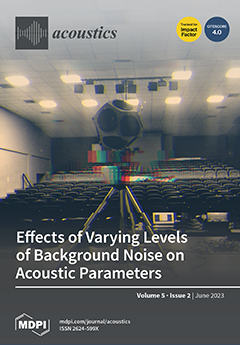Typically, background noise of different types and levels is present during the measurement of the impulse response in spaces. The two methods that are, in practice, most frequently used in the measurement of the impulse response, are the exponential sine sweep (ESS), and
[...] Read more.
Typically, background noise of different types and levels is present during the measurement of the impulse response in spaces. The two methods that are, in practice, most frequently used in the measurement of the impulse response, are the exponential sine sweep (ESS), and the maximum length sequence (MLS). This study’s objective was to estimate the impact of background noise (white noise, tonal noise) on the acoustic parameters (
T30, EDT,
C80, and
D50) for ESS and MLS measurements, by introducing artificial background noise, employing an external sound source. For this purpose, measurements were performed with varying levels of external noise (in steps of 2 dB), and the effect was assessed, using the relative error compared to measurements without artificial background noise. According to the findings for white noise (as background noise), in the case of
T30 and EDT, the difference between the two methods, as well as the relative error, for the initial levels of added background noise, was small. However, for higher levels of added background noise, there was a sharp increase in the relative error, which was greater for the ESS method, both for
T30 and EDT. Regarding
C80 and
D50, while initially the differences between the ESS and MLS methods were small, cumulatively, as the background noise increased, the relative error increased for both methods, with the ESS method showing the largest error. In the case of tonal noise (as background noise), the results were consistent with those observed in the case of white noise. The study’s findings contribute to a better understanding of the ESS and MLS methods, and suggest the expected relative error of acoustic parameters when various types and levels of background noise are present. Additionally, the study suggests, based on background noise and level, the optimum method to conduct impulse response measurements.
Full article





